Extensive pits are worked in the downs for the chalk, which is used for manure, burning into lime, &c. A stratum of coals was formerly believed to run through the central downs, and Sir Rt. Worsley actually sunk a shaft for it near Bembridge; his labors however were but poorly rewarded. Veins of coarse iron ore have also appeared in some parts of the island.
The finest white sand in the kingdom is obtained from the sea-cliffs at Freshwater, and is carried in great quantities to the glass and porcelain manufactories. Excellent brick-earth abounds in almost every part of the island: common native alum, copperas, specimens of petrifactions, and many curious varieties of sea-weeds, are picked up on the shores; in the cliffs and quarries are found numerous beautiful fossil remains,—especially oysters and other bivalve shells, of a vast size.
The central range of chalk hills divides the island into two nearly distinct regions, the soil and strata being essentially different,—a stiff clay predominating on the north side, which is extensively covered with wood, while the south side is principally of a light sandy soil or mellow loam, and being exceedingly fertile, the whole tract is almost exclusively employed in tillage.
In geological terms, the north is formed of the Eocene or freshwater deposits: and the south of the Cretaceous or oceanic, except where the Wealden exhibits itself at Sandown and Brixton bays.—Though affording a great variety of soil, the island is upon the whole well calculated for farming as may be inferred from its proverbial fertility; “it was many years ago computed to produce as much corn in one year as its inhabitants would consume in seven,—and the improved cultivation, with the additional land brought into tillage, has doubtless kept pace with the increased population.”
In AGRICULTURE there is now a close approximation to the routine practised in the rest of the county: and there is scarcely any peculiarity observable either in the system of Husbandry, or in the manners of the Yeomanry, who are a very intelligent and respectable class.
The constant intercourse which the inhabitants have with persons from other parts of the kingdom, has in fact erased all insular peculiarities. But the following extract from the Memoirs of Sir John Oglander, which were written about the year 1700, will be read with interest, as exhibiting a most
Amusing Picture of the Islanders in the 16th century.
“I have heard,” says he, “and partly knowe it to be true, that not only heretofore there was no lawyer nor attorney in owre island, but in Sir George Carey’s time [1588] an attorney coming in to settle in the island, was by his command, with a pound of candles hanging att his breech lighted, with bells about his legs, hunted owte of the island; insomuch that owre ancestors lived here so quietly and




